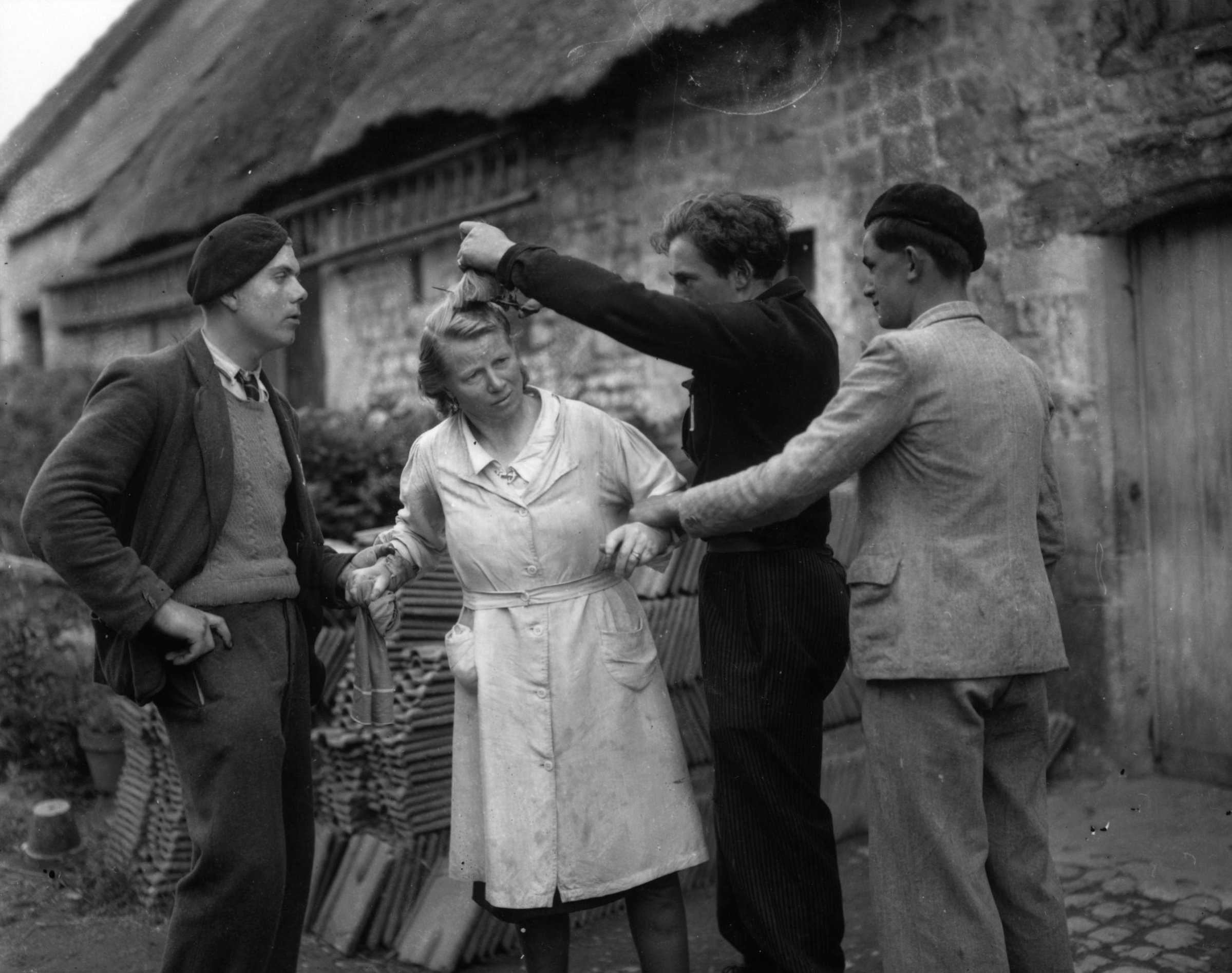
They called it the épuration sauvage, the wild purge, because it was spontaneous and unofficial. But, yes, it was savage, too. In the weeks and months following the D-Day landings of June 6, 1944, Allied troops and the resistance swept across France liberating towns and villages, and unleashing a flood of collective euphoria, relief and hope. And then the punishments began.
The victims were among the most vulnerable members of the community: Women. Accused of “horizontal collaboration” — sleeping with the enemy — they were targeted by vigilantes and publicly humiliated. Their heads were shaved, they were stripped half-naked, smeared with tar, paraded through towns and taunted, stoned, kicked, beaten, spat upon and sometimes even killed.
One photograph from the era shows a woman standing in a village as two men forcibly restrain her wrists; a third man grabs a hank of her blonde hair, his scissors poised to hack it away. Just as the punished were almost always women, their punishers were usually men, who acted with no legal mandate or court-given authority. Although some were loyal resistance members, others had themselves dabbled in collaborationist activity and were anxious to cleanse their records before the mob turned on them, too. About 6,000 people were killed during the épuration sauvage — but the intense, cruel, public ferocity of the movement focused not on serious collaborationist crime. Instead, it zeroed in on women accused of consorting with the enemy.
When I first started researching a novel about France during the Second World War, I was expecting to find horrors that took place during the dark years of the Nazi Occupation. Instead, I was surprised to discover that, for thousands of women, the Liberation marked the beginning of a different nightmare. At least 20,000 French women are known to have been shorn during the wild purge that occurred in waves between 1944 to 1945 — and the historian Anthony Beevor believes the true figure may be higher.
Read more: Robert Capa Reveals an Ugly Side of Liberation in WWII France
The suspicion and punishment of women after World War II is part of a cycle of repression and sexism that began long before D-Day and continues to be seen today, in the conversation around the #MeToo movement. It begins with a terrible event, then women get blamed, then aggressively attacked and finally the assault is forgotten. In the 74 years since the D-Day landings, the barbarity of the épuration sauvage — its violence against women — has often been overlooked. As I learned more about these women, their stories and images haunted me, compelling me to write about them. The result is my novel, The Lost Vintage, which features a character accused of horizontal collaboration.
Some of the women had, indeed, slept with Nazi soldiers. Some were prostitutes. But some were raped. Some were the targets of personal revenge, framed and falsely accused. Some had only the briefest contact with their occupiers, as was the case of a funeral wreath maker in Toulouse. One day she was working at home next to an open window when a German soldier strolled up and began talking to her. Their entire conversation took place at the window — he never even entered her house. After the Liberation, a witness would later recall, a mob came for her, stripping and shearing her, dragging her through town as her teenage daughter cowered behind.
The majority of the punished were single — unmarried, widowed, or married women whose husbands were prisoners of war. For single mothers, sleeping with a German was sometimes the only way to obtain food for their starving children.
It didn’t just happen in France. Other countries in occupied Europe, including Belgium, Italy, the Netherlands and Norway, witnessed similar acts, albeit on a smaller scale. Historians estimate that hundreds of thousands of women were used as sexual slaves for the Japanese military; in 1993, Japan’s chief cabinet secretary formally acknowledged the “coercive atmosphere” and apologized, but this piece of history remains controversial to this day. After the war, many of these “comfort women” died as a result of what they had been through, some committed suicide, and many of those who survived hid their trauma for the rest of their lives.
Recognizing these women now is an important step in acknowledging the long history of gender inequality. With little ability to defend themselves — no courts, no juries — the shorn women became the public target of a humiliated nation, a convenient scapegoat to pummel, demean and discard, all in an attempt to wash away the shame of defeat and submission.
It is time to ask why these women paid the price for the sins of men. It is time to recognize that these women, too, were the victims of sexual harassment and assault. It is time to remove their story from the shadows, and share it in an effort to stop the cycle from continuing. It happened to them, too.
Ann Mah is the author of The Lost Vintage, available June 19.
More Must-Reads from TIME
- L.A. Fires Show Reality of 1.5°C of Warming
- Home Losses From L.A. Fires Hasten ‘An Uninsurable Future’
- The Women Refusing to Participate in Trump’s Economy
- Bad Bunny On Heartbreak and New Album
- How to Dress Warmly for Cold Weather
- We’re Lucky to Have Been Alive in the Age of David Lynch
- The Motivational Trick That Makes You Exercise Harder
- Column: No One Won The War in Gaza
Contact us at letters@time.com